Welcome to another exciting exploration into the fascinating world of birds. In this post, we’re embarking on a comparative study, focusing on the striking Cranes and their avian look-alikes. We’ll delve into the unique traits of 13 different bird species, including herons, egrets, spoonbills, ibises, storks, flamingos, and the distinct Limpkin. Let’s dive in and discover!
List of Birds That look like cranes
Herons and Egrets – Great Blue Heron, Great Egret, Snowy Egret, Reddish Egret, Black-Crowned Night-Heron, Tricolored Heron
Ibises and Spoonbills – Roseate Spoonbill, White-faced Ibis, Eurasian Spoonbill
Storks – Wood Stork, White Stork
Flamingos – Greater Flamingo
Others – Limpkin Bird
There are approximately 15 species of cranes spread across the globe, each one with its distinct characteristics. The iconic Sandhill Crane is well-known in North America for its large size and red forehead, while Whooping Crane, is native to North America. Whooping cranes is famous for its white body and red crown. Europe and Asia host several species, including the elegant Eurasian Crane, known for its grey body and white facial streak.
The stately Red-crowned Crane, considered a symbol of luck, longevity, and fidelity in many Asian cultures, boasts striking black and white plumage with a patch of red atop its head. Down in Africa, the regal Grey Crowned Crane is celebrated for its golden headdress of stiff golden feathers. And let’s not forget the Blue Crane, the national bird of South Africa, known for its light blue-grey plumage and long, dark grey wing plumes. These are just a few examples of the magnificent crane species that inhabit our world, each contributing its unique beauty to the global bird mosaic.
Sandhill Crane

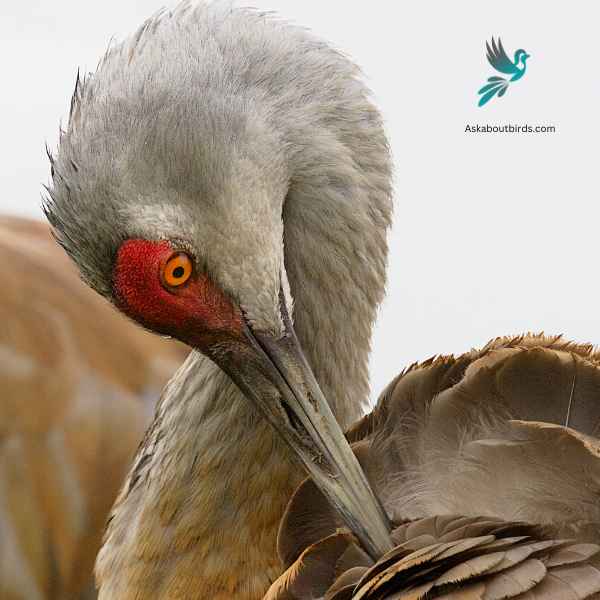
| Feature | Measurement |
|---|---|
| Scientific Name | Antigone canadensis |
| Length | 2 ft 7 in to 4 ft 6 in |
| Wingspan | 16.5–23.6 in |
| Weight | 4.02-4.57 kg |
The Sandhill Crane (Antigone canadensis) is a distinguished bird species found in the family Gruidae, renowned for its majestic presence and elaborate courtship dances.
These long-legged birds stand approximately 4 feet tall with a wingspan of up to 7 feet, marked by gray bodies, white cheeks, pointy dark bills, and an iconic red cap on their heads. Typically, they inhabit grasslands, marshes, and fields across North America, Siberia, and Cuba.
Being omnivorous, Sandhill Cranes thrive on a varied diet consisting of plant material, small mammals, amphibians, and insects. With a lifespan reaching up to 20 years in the wild, they remain one of the most widespread crane species globally.
Great Blue Heron
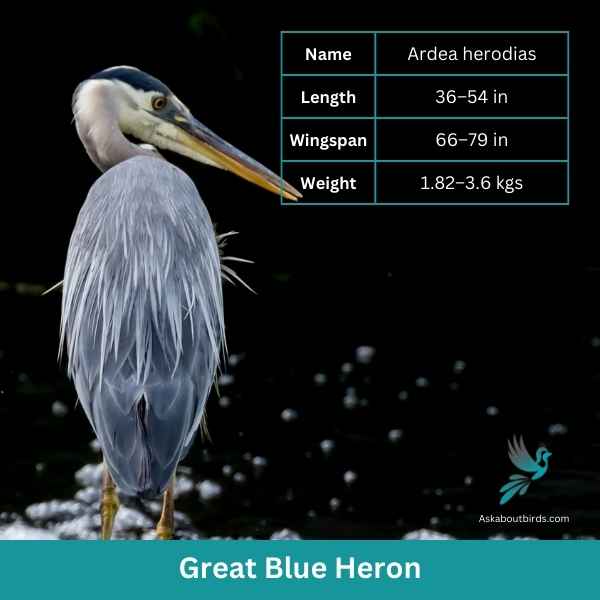
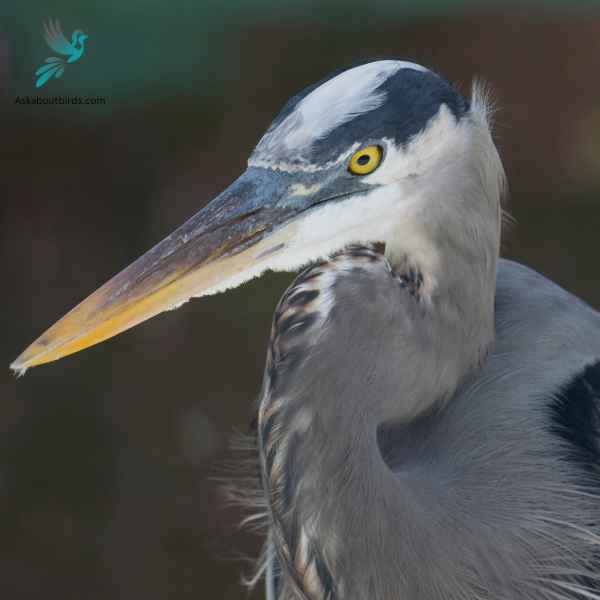
| Feature | Measurement |
|---|---|
| Scientific Name | Ardea herodias |
| Length | 36–54 in |
| Wingspan | 66–79 in |
| Weight | 1.82–3.6 kgs |
Great Blue Herons are the largest heron species in North America, is distinguished by its tall stature and unique blue-gray plumage.
Measuring up to 4.5 feet tall with a wingspan of approximately 6.5 feet, the bird features a long, pointed bill, a white head with a black eye stripe extending to slender black plumes, and robust, elongated legs. Its distinctive flight pattern, forming a tight “S” shape with its neck, sets it apart from similar large birds, like cranes.
Inhabiting various wetland habitats, including marshes, lakes, rivers, and coastal regions throughout much of North and Central America, the Great Blue Heron is a wading bird. Often seen poised statue-like at the water’s edge, these birds are expert hunters, spearing fish and capturing small animals with their sharp bills.
Great Blue Heron vs. Crane
Similarities
- Size and Body Shape: Both Great Blue Herons and Cranes are large birds with long legs and necks, suited for their wading and foraging habits in shallow waters.
- Diet: Both species are opportunistic feeders, with a diet consisting primarily of fish, but also including other small aquatic creatures, insects, and even small mammals.
- Habitat: Both species tend to inhabit similar environments, including wetlands, marshes, and the edges of bodies of water.
Differences
- Neck Shape: When flying, a Great Blue Heron folds its neck into an “S” shape, while Cranes fly with their necks straight out.
- Color: Great Blue Herons, as their name suggests, are predominantly blue-gray with a broad black stripe over the eye, while most Crane species are usually gray, white, or a mix of the two.
- Feathers: Great Blue Herons have a distinctive plume of feathers on their chest and back, a feature typically not seen in Cranes.
Roseate Spoonbill

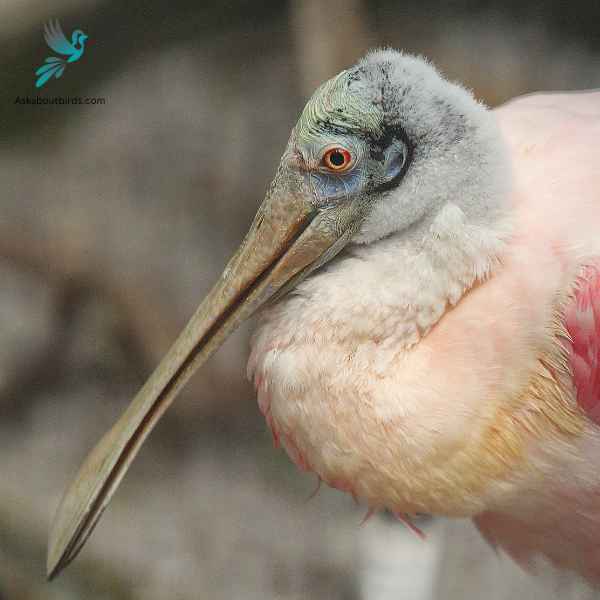
| Feature | Measurement |
|---|---|
| Scientific Name | Platalea ajaja |
| Length | 28–34 in |
| Wingspan | 47–52 in |
| Weight | 1.2–1.8 kg |
The Roseate Spoonbill (Platalea ajaja) is a large, long-legged wading bird known for its unique spoon-shaped bill and striking pink plumage, from which it derives its name.
The species’ eye-catching coloration ranges from light pink to bright magenta, accentuated by a patch of carmine red on the wing and a greenish tinge on the head and neck. The spoon-shaped bill, broad and flat at the end, is a highly specialized tool for feeding, allowing the bird to sweep through the water and scoop up small aquatic animals.
Residing in marshes, lagoons, and mangroves, the Roseate Spoonbill is found in the Americas, from the southern United States through Central America and into South America. They feed on crustaceans and other small aquatic animals, the carotenoid pigments of which contribute to their vibrant pink color.
Roseate Spoonbill vs. Crane
Similarities
- Size and Body Shape: Both Roseate Spoonbills and Cranes are tall birds with long legs and long necks, reflecting their habits of foraging in water and wetlands.
- Diet: Both species are opportunistic feeders, eating a range of aquatic invertebrates, small fish, and insects.
- Habitat: Both species often inhabit wetland environments and are commonly found near bodies of water.
Differences
- Bill Shape: The Roseate Spoonbill gets its name from its distinctive spoon-shaped bill, a feature quite different from the straight, pointed bills of Cranes.
- Color: Roseate Spoonbills have a unique pink coloration, earned from their diet rich in carotenoids. Cranes, on the other hand, usually exhibit grey, white, or a combination of both.
- Flight Pattern: While flying, Roseate Spoonbills extend their neck, similar to Cranes. However, Spoonbills alternate between flapping and soaring, whereas Cranes typically maintain steady, rowing wingbeats.
White-faced Ibis
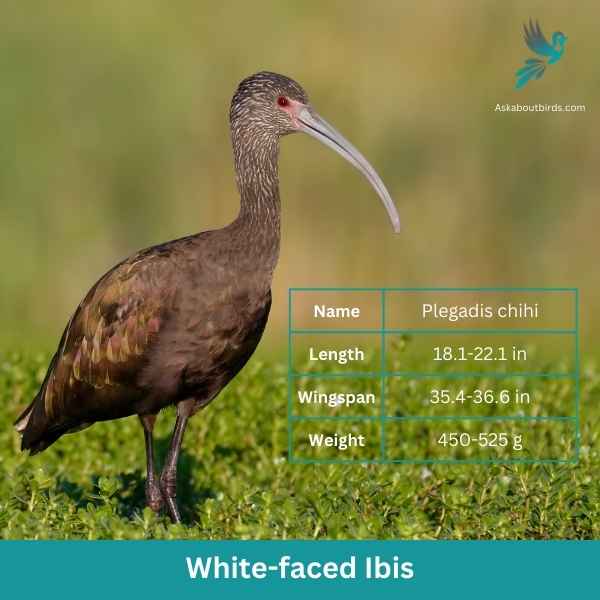
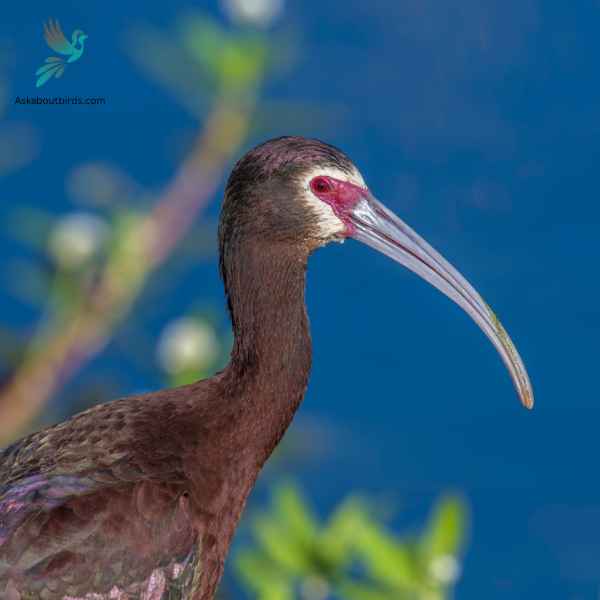
| Feature | Measurement |
|---|---|
| Scientific Name | Plegadis chihi |
| Length | 18.1-22.1 in |
| Wingspan | 35.4-36.6 in |
| Weight | 450-525 g |
The White-faced Ibis (Plegadis chihi) is a wading bird notable for its distinctive and colorful appearance. It boasts a long, curved bill, a slender body, and a predominantly dark, glossy plumage that shimmers with iridescent hues of green and purple in the sunlight.
The bird derives its name from the patch of white feathers bordering the bare, red skin on its face, a feature most prominent during the breeding season.
Inhabiting the marshes, wetlands, and fields of the central and western United States, as well as parts of Central and South America, the White-faced Ibis uses its long, curved bill to probe mud and shallow water for various invertebrates and crustaceans. The species tends to nest in colonies, often sharing habitat with other wading birds.
White-faced Ibis vs. Crane
Similarities
- Size and Body Shape: Both White-faced Ibis and Cranes are tall birds with long legs and necks, allowing them to wade in shallow waters and wetlands.
- Diet: Both species are opportunistic feeders, eating a variety of aquatic invertebrates, small fish, and amphibians.
- Habitat: Both species are usually found in similar wetland habitats, including marshes, mudflats, and the edges of bodies of water.
Differences
- Bill Shape: The White-faced Ibis has a long, curved bill used for probing in mud and shallow water, which is quite different from the straight, pointed bills of Cranes.
- Color: White-faced Ibises have a dark reddish-brown body with a metallic sheen, quite different from the more subdued hues of gray, white, or a mix of the two found in Cranes.
- Face: True to its name, the White-faced Ibis has white feathers around its bare, red face, which is not a feature typically seen in Cranes.
Great Egret
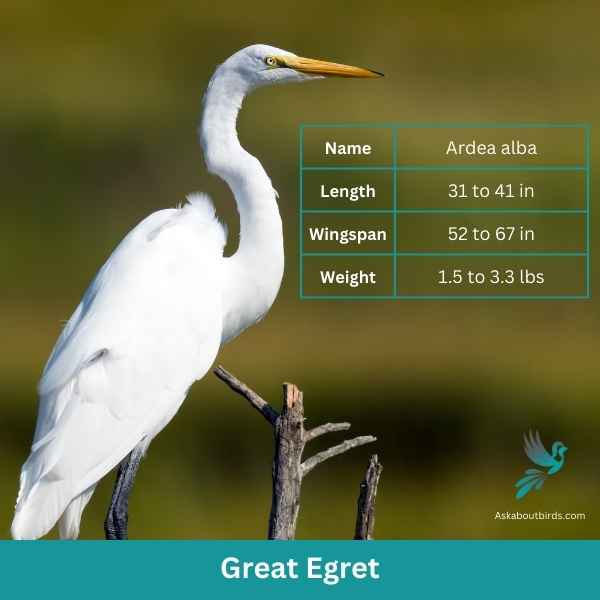
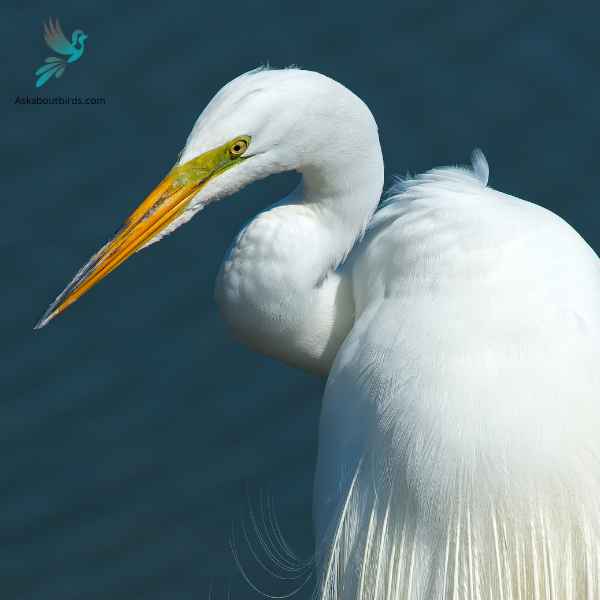
| Feature | Measurement |
|---|---|
| Scientific Name | Ardea alba |
| Length | 31 to 41 in |
| Wingspan | 52 to 67 in |
| Weight | 1.5 to 3.3 lbs |
The Great Egret (Ardea alba), also known as the Common Egret, is a large, elegant wading bird recognized for its brilliant white plumage, slender black legs, and long, dagger-like yellow bill.
With a height of up to 3.3 feet and a wingspan of 52 to 67 inches, this bird is amongst the largest of the heron species. Its stately appearance and serene comportment have made it a popular symbol in many cultures and an eye-catching sight in its habitats.
Found across all continents except Antarctica, the Great Egret resides in both fresh and saltwater wetlands, including marshes, ponds, and coastal areas. It feeds mainly on fish, but it also hunts amphibians, small mammals, and invertebrates.
Great Egret vs. Crane
Similarities
- Size and Body Shape: Both Great Egrets and Cranes are tall birds with long legs and necks, which enable them to forage in shallow water and wetlands.
- Diet: Both species are opportunistic feeders, with a diet composed of fish, frogs, small mammals, and aquatic invertebrates.
- Habitat: Both species prefer similar habitats that include wetlands, marshes, ponds, and riverbanks.
Differences
- Color: Great Egrets are almost entirely white, while Cranes are typically gray or white, and often have additional colors on their heads or necks.
- Neck Shape: While flying, a Great Egret retracts its neck, forming an “S” shape, while Cranes fly with their necks straight out.
- Bill Shape and Color: Great Egrets have a long, pointed yellow bill, quite different from the pointed, often gray or greenish bills of Cranes.
Snowy Egret

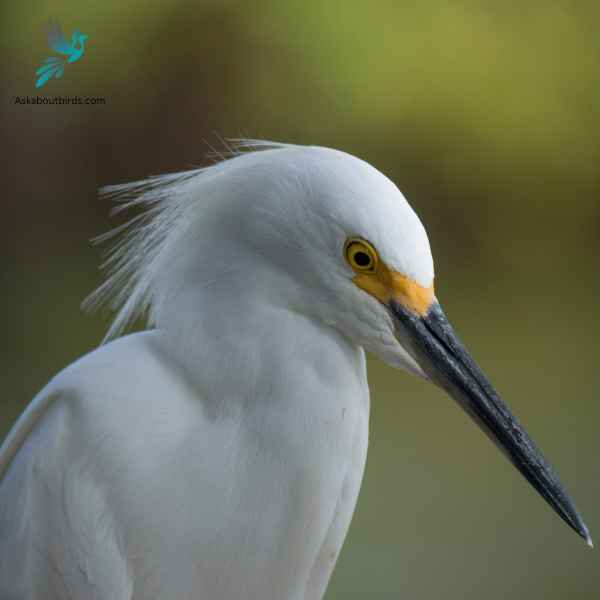
| Feature | Measurement |
|---|---|
| Scientific Name | Egretta thula |
| Length | 22.1–26.0 in |
| Wingspan | 39.4 in |
| Weight | 370 g |
The Snowy Egret (Egretta thula) is a small and active wading bird, celebrated for its delicate beauty. It sports an entirely white plumage that appears to glow against its black bill and legs, and striking yellow feet, which often play a crucial role in luring prey during feeding.
The Snowy Egret is further adorned with fine, plume-like feathers on its head, neck, and back during the breeding season, making it one of the more distinctive heron species.
Inhabiting wetland areas across the Americas, the Snowy Egret can be found in marshes, swamps, shorelines, and tidal flats where it feeds primarily on fish, but also consumes insects, crustaceans, and small reptiles.
Snowy Egret vs. Crane
Similarities
- Size and Body Shape: Both Snowy Egrets and Cranes are tall birds with long legs and necks, perfect for their wading and foraging habits in shallow waters.
- Diet: Both species feed on a variety of aquatic creatures, including fish, frogs, and invertebrates.
- Habitat: Both species tend to inhabit similar environments, such as wetlands, marshes, and the edges of bodies of water.
Differences
- Size: Snowy Egrets are smaller than most Cranes. Snowy Egrets typically reach a height of about 24 inches, whereas Cranes can stand 35 inches tall or more.
- Color: Snowy Egrets are entirely white with black legs and bright yellow feet, while Cranes are typically gray or white, and often have additional colors on their heads or necks.
- Neck Shape: When flying, a Snowy Egret retracts its neck, forming an “S” shape, whereas Cranes fly with their necks straight out.
Black-Crowned Night-Heron


| Feature | Measurement |
|---|---|
| Scientific Name | Nycticorax nycticorax |
| Length | 22.8-26.0 in |
| Wingspan | 45.3-46.5 in |
| Weight | 727-1014 g |
The Black-Crowned Night-Heron (Nycticorax nycticorax) is a medium-sized heron species known for its distinct nocturnal habits and characteristic appearance. The bird displays a stocky silhouette, with a black crown and back, contrasting starkly with its light grey wings and white underparts.
Its eyes are large and red, adapted for its night-time activities, and its legs are relatively short for a heron. The bill is sturdy and black, and during the breeding season, two to three long white plumes extend from the back of the head.
Residing in a wide variety of wetland habitats, from freshwater marshes to coastal regions, the Black-Crowned Night-Heron is found across a large global range, including the Americas, Europe, Asia, and Africa. The species primarily feeds on fish and invertebrates, but it is known to be opportunistic and will also eat small mammals, birds, and eggs.
Black-Crowned Night-Heron vs. Crane
Similarities
- Diet: Both Black-Crowned Night-Herons and Cranes feed on a variety of aquatic animals, including fish, amphibians, and invertebrates, but also eat small mammals and birds.
- Habitat: Both species can be found in similar wetland habitats, including marshes, swamps, and the edges of lakes or rivers.
- Nesting: Both species build nests in marshy or reedy areas, sometimes in trees or shrubs.
Differences
- Size and Body Shape: Black-Crowned Night-Herons are significantly smaller and stockier than Cranes, with a height of about 23-28 inches compared to the average Crane, which can stand 35 inches tall or more.
- Color and Markings: Black-Crowned Night-Herons have a distinctive black crown and back, with a white or grey underside, whereas Cranes are typically gray or white, and often have additional colors on their heads or necks.
- Neck Shape: Black-Crowned Night-Herons have a shorter neck compared to Cranes, and they typically pull their neck in close to their body, particularly when in flight, whereas Cranes fly with their necks straight out.
Tricolored Heron
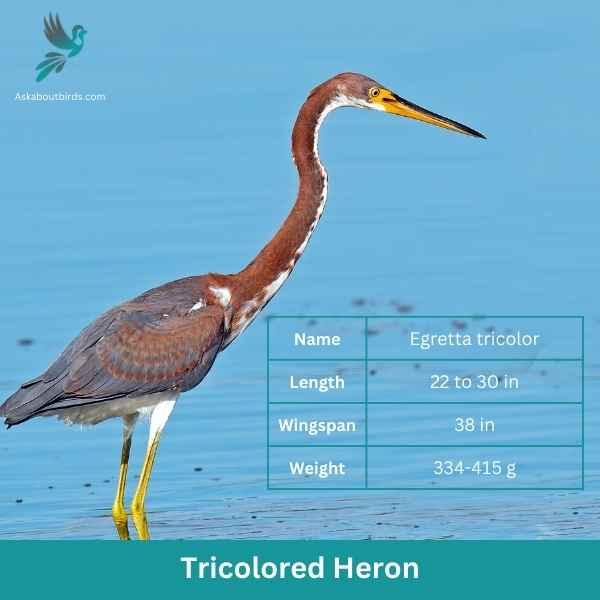
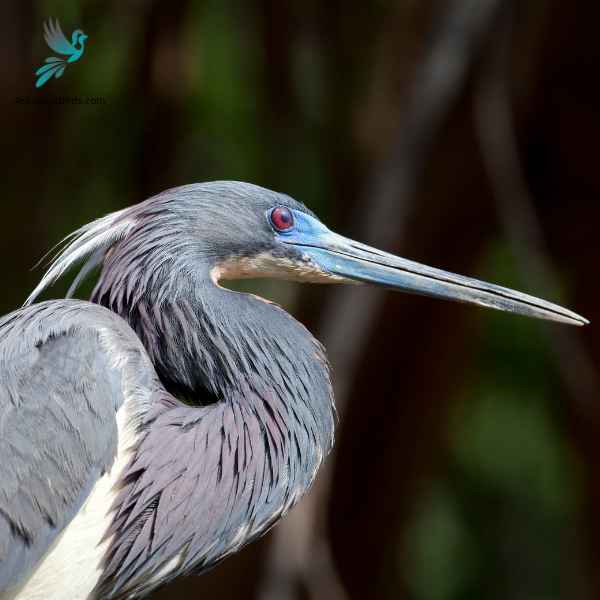
| Feature | Measurement |
|---|---|
| Scientific Name | Egretta tricolor |
| Length | 22 to 30 in |
| Wingspan | 38 in |
| Weight | 334-415 g |
The Tricolored Heron (Egretta tricolor), formerly known as the Louisiana Heron, is a slender, medium-sized heron species recognized for its distinctive three-colored plumage.
It exhibits a blue-gray body contrasted by a white belly and a rust-colored neck, which deepens to a maroon shade during the breeding season. The long, pointed yellowish bill turns blue at the base in breeding adults, further accenting its striking appearance.
Native to coastal parts of the southeastern United States, the Tricolored Heron inhabits salt marshes, mangrove swamps, tidal flats, and freshwater wetlands. It feeds on a diet primarily of small fish, utilizing a unique hunting technique where it often runs through shallow water, spreading its wings to create shade and startle prey.
Tricolored Heron vs. Crane
Similarities
- Size and Body Shape: Both Tricolored Herons and Cranes are tall birds with long legs and necks, built for wading and foraging in shallow water and wetlands.
- Diet: Both species are opportunistic feeders, with a diet that includes a variety of fish, amphibians, and invertebrates.
- Habitat: Both species prefer similar wetland habitats, including marshes, swamps, and riverbanks.
Differences
- Size: Tricolored Herons are generally smaller than Cranes. Tricolored Herons typically reach a height of about 22-30 inches, while Cranes can stand over 35 inches tall.
- Color: Tricolored Herons have a unique combination of blue-gray, lavender, and white, with a white belly and rufous neck – quite different from the typical gray or white of Cranes.
- Neck Shape: When flying, a Tricolored Heron pulls its neck into an “S” shape, while Cranes fly with their necks straight out.
Wood Stork
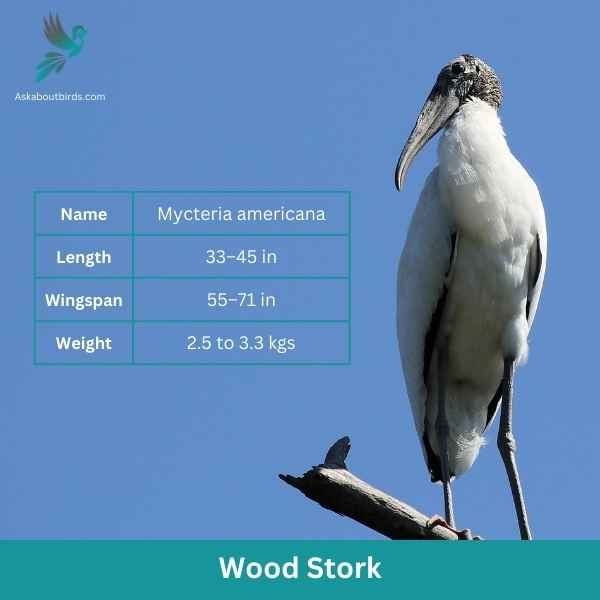
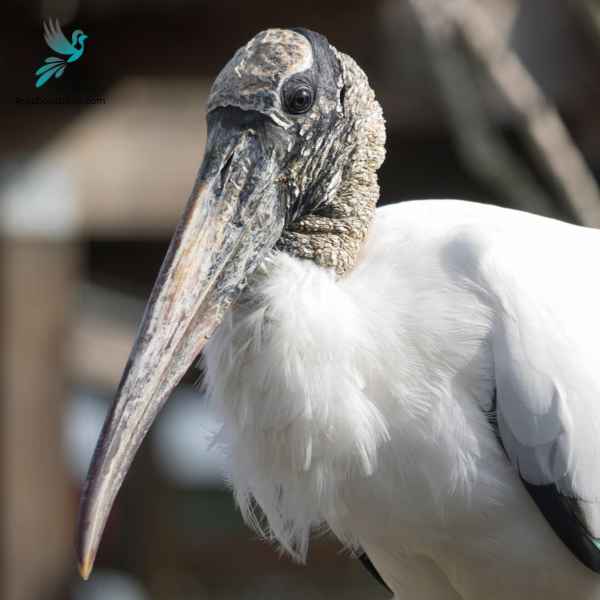
| Feature | Measurement |
|---|---|
| Scientific Name | Mycteria americana |
| Length | 33–45 in |
| Wingspan | 55–71 in |
| Weight | 2.5 to 3.3 kgs |
The Wood Stork (Mycteria americana) is a large, long-legged wading bird, notable for its striking contrast of white body plumage with a dark, featherless head and neck. Its wings are expansive and black, making it particularly conspicuous in flight.
The Wood Stork’s long, down-curved bill is specialized for a unique method of feeding called “tactile foraging,” where the bird catches small fish and invertebrates by feeling their movements in the water.
Found in wetland habitats of the southeastern United States, Central America, and South America, the Wood Stork relies heavily on the presence of shallow water bodies for feeding.
Wood Stork vs. Crane
Similarities
- Size and Body Shape: Both Wood Storks and Cranes are large birds with long legs and necks, reflecting their habits of foraging in water and wetlands.
- Diet: Both species are opportunistic feeders, consuming a diet consisting primarily of fish, but also including other small aquatic creatures, insects, and even small mammals.
- Habitat: Both species often inhabit wetland environments and are commonly found near bodies of water.
Differences
- Head and Neck: Wood Storks have a distinctive bald, scaly head and a long, thick, curved bill, which is quite different from the feathered heads and straight, pointed bills of Cranes.
- Color: Wood Storks are primarily white with black flight feathers, unlike Cranes which are usually grey, white, or a mix of both, and often have additional colors on their heads or necks.
- Feeding Method: Wood Storks are tactile feeders, using their bill to feel for prey in murky water, while Cranes are visual feeders.
Reddish Egret
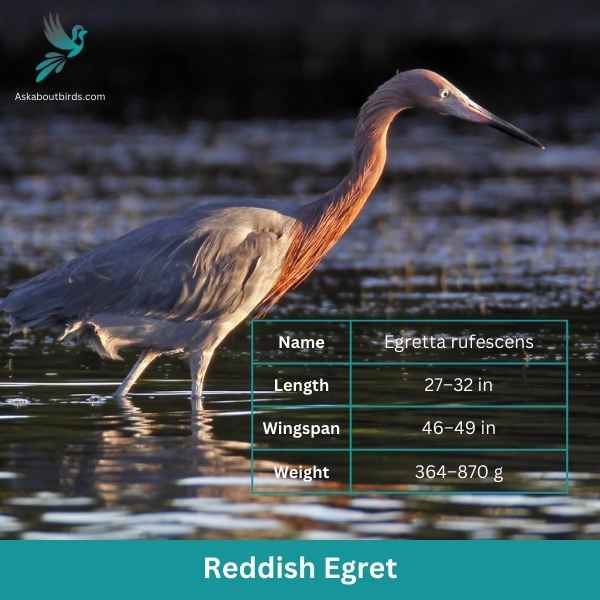
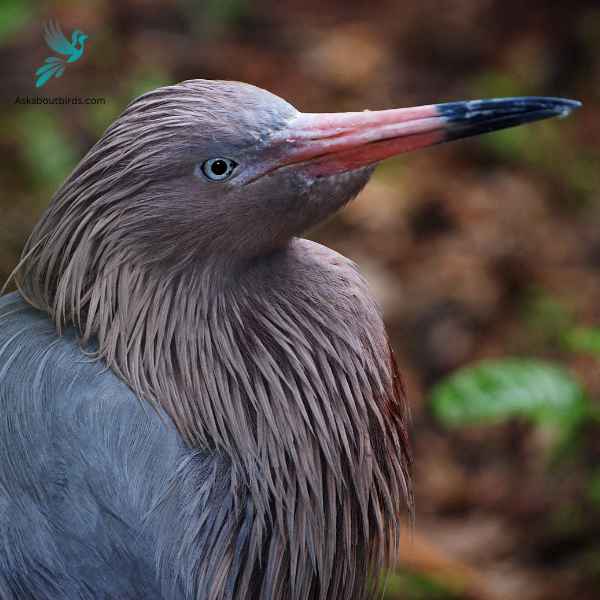
| Feature | Measurement |
|---|---|
| Scientific Name | Egretta rufescens |
| Length | 27–32 in |
| Wingspan | 46–49 in |
| Weight | 364–870 g |
The Reddish Egret (Egretta rufescens) is a medium-sized heron species recognized for its unusual coloration and lively hunting behavior.
It comes in two distinct color morphs: a dark form that displays a bluish body with a reddish neck and head, and a white form that is entirely white. Its bill is pink at the base, transitioning to black towards the tip, and its legs and feet are bluish-gray.
The Reddish Egret’s habitat stretches along the coastal regions of the southern United States, Mexico, Central America, and the Caribbean, where it frequents saltwater marshes, lagoons, and shallow bays. It is known for its “dance” when hunting, running in shallow water with wings spread and dipping its head to catch fish.
Reddish Egret vs. Crane
Similarities
- Size and Body Shape: Both Reddish Egrets and Cranes are tall birds with long legs and necks, which enable them to forage in shallow water and wetlands.
- Diet: Both species are opportunistic feeders, with a diet composed primarily of fish, but also including other small aquatic creatures and invertebrates.
- Habitat: Both species prefer similar habitats, which typically include wetlands, marshes, and the edges of bodies of water.
Differences
- Color: Reddish Egrets are unique for their bluish-gray body and reddish neck, which is starkly different from the typical gray or white coloration of Cranes.
- Feeding Behavior: Reddish Egrets are known for their active hunting style, often running, jumping, and spinning in the pursuit of prey, a behavior not commonly seen in Cranes.
- Neck Shape: When flying, a Reddish Egret pulls its neck into an “S” shape, whereas Cranes fly with their necks straight out.
Eurasian Spoonbill
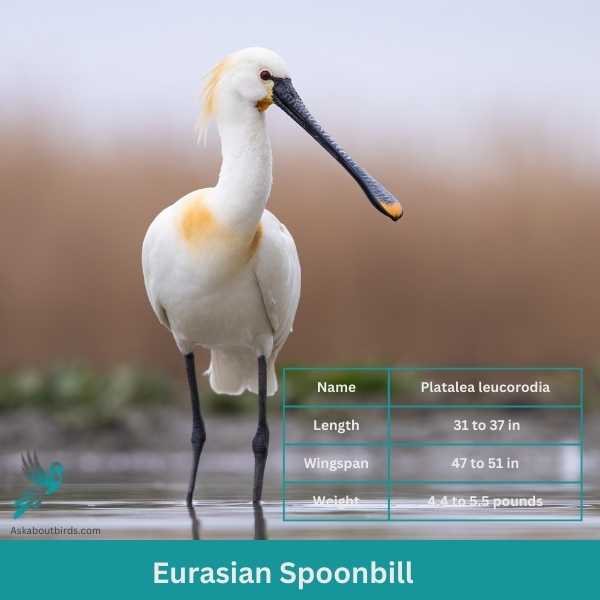
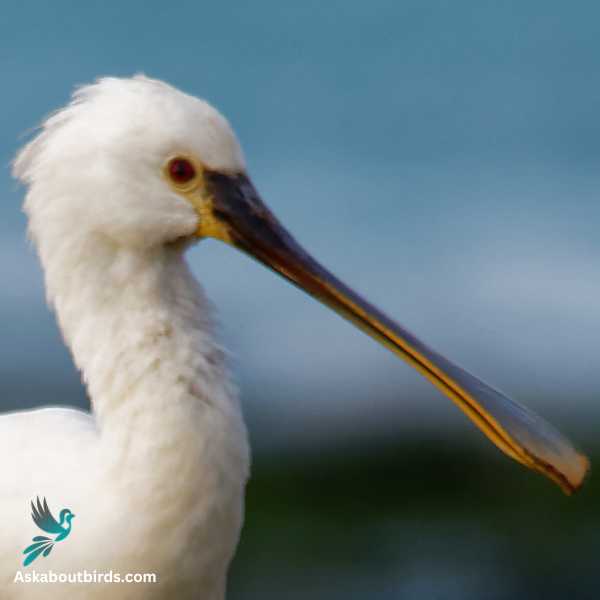
| Feature | Measurement |
|---|---|
| Scientific Name | Platalea leucorodia |
| Length | 31 to 37 in |
| Wingspan | 47 to 51 in |
| Weight | 4.4 to 5.5 pounds |
The Eurasian Spoonbill is a medium-sized, pure white bird with an unusual spoon-shaped bill. Eurasian Spoonbills spend much of their time feeding in the shallow waters of wetlands, lakes, and marshes on fish, frogs, and aquatic insects, which they detect by their sense of touch as they rhythmically sweep their ‘spoon-shaped’ bills from side to side.
The Eurasian Spoonbill is a medium-sized, long-legged wading bird. Its distinctive bill is long, flat, and spoon-shaped at the end. It is mainly white with a yellowish crest and black bill and legs during the breeding season. The immature Spoonbill is dull white with a shorter crest and bill.
The Eurasian Spoonbill’s vocal sounds are generally quiet but can emit low, guttural grunts.
Eurasian Spoonbill vs. Crane
Similarities
- Size and Body Shape: Both Eurasian Spoonbills and Cranes are tall birds with long legs and necks, designed for wading in shallow waters and wetlands.
- Diet: Both species primarily feed on aquatic animals, such as fish and small invertebrates.
- Habitat: Both species inhabit similar wetland environments, including marshes, swamps, and the edges of bodies of water.
Differences
- Bill Shape: The Eurasian Spoonbill has a long, flat, spoon-shaped bill, which is unique and significantly different from the pointed, often straight bills of Cranes.
- Color: The Eurasian Spoonbill is primarily white with a yellowish crest during the breeding season, in contrast to Cranes which are usually gray, white, or a combination of the two, often with additional colors on their heads or necks.
- Feeding Method: Eurasian Spoonbills sweep their bills from side to side in the water to catch food, a distinctive method not seen in Cranes.
White Stork
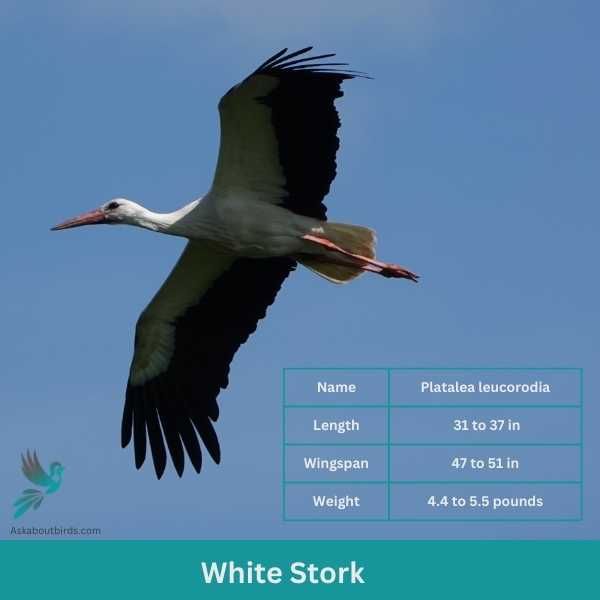

| Feature | Measurement |
|---|---|
| Scientific Name | Ciconia ciconia |
| Length | 39–45 in |
| Wingspan | 61–85 in |
| Weight | 5.1–9.7 lb |
The White Stork is a large, elegant bird notable for its contrasting black and white plumage. These storks forage in grasslands and shallow wetlands, hunting for a range of food items, including insects, fish, amphibians, reptiles, small mammals, and birds.
The White Stork is a tall, long-legged wading bird. Its distinctive bill is long, straight, and pointed, perfectly adapted for hunting. Adults are primarily white with black flight feathers, while the legs and the long bill are bright red. Immature storks resemble adults but have duller plumage and a darker bill.
The vocal sounds of the White Stork are not as prominent, as they are mostly silent. However, they are known for their unique way of communication through “bill-clattering”, a rapid opening and closing of their beak producing a rattle-like sound.
White Stork vs. Crane
Similarities
- Size and Body Shape: Both White Storks and Cranes are large birds with long legs and long necks, well-suited for their wading and foraging habits.
- Diet: Both species feed on a variety of animals such as fish, amphibians, insects, and small mammals.
- Habitat: Both species can be found in similar environments, including open farmland, wetlands, and grasslands.
Differences
- Coloration: White Storks, as their name implies, are predominantly white with black flight feathers, while Cranes are typically grey or white, often with additional colors on their heads or necks.
- Bill Shape: White Storks have long, straight, pointed bills, whereas many Cranes have a more elongated and curved bill.
- Migration: White Storks are well-known for their long-distance annual migrations between Europe and Africa, while many Crane species, such as the Sandhill Crane, migrate between North and South America or within Asia.
Greater Flamingo
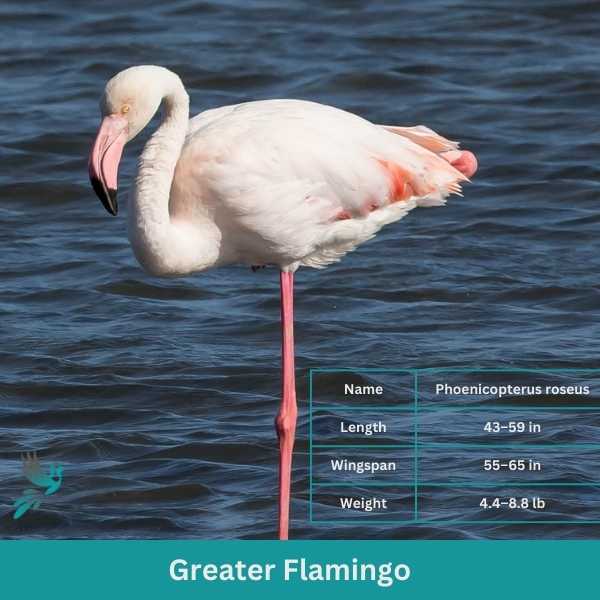
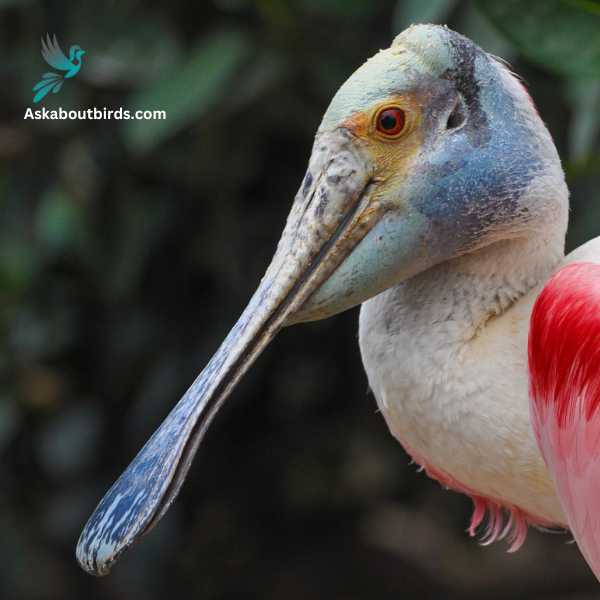
| Feature | Measurement |
|---|---|
| Scientific Name | Phoenicopterus roseus |
| Length | 43–59 in |
| Wingspan | 55–65 in |
| Weight | 4.4–8.8 lb |
The Greater Flamingo is a large and majestic bird known for its distinctive pink hue. These flamingos often gather in large colonies in shallow water bodies, feeding primarily on small aquatic creatures such as shrimp, mollusks, and algae which contribute to their pink color.
The Greater Flamingo is an incredibly tall, long-legged wading bird. Its signature bill is downward bending, pink with a black tip, and is unique in its filtering capabilities. The plumage ranges from pale pink to a brighter pink, and the intensity depends on the bird’s diet. The legs of the Greater Flamingo are also pink and quite lengthy, contributing to the bird’s tall stature. Young flamingos are grey and white and acquire the pink coloration after about two years.
The vocal sounds of the Greater Flamingo are quite varied, often described as goose-like honking, mumbling, or grunting noises, particularly noticeable in large colonies.
Greater Flamingo vs. Crane
Similarities
- Size and Body Shape: Both Greater Flamingos and Cranes are large, tall birds with long necks and legs, suitable for foraging in shallow waters.
- Diet: Both species feed mainly on aquatic invertebrates and small fish, which they forage from the water with their bills.
- Habitat: Both species are commonly found in wetland environments and are often seen near bodies of water.
Differences
- Color: Greater Flamingos are known for their vibrant pink coloration, a result of their diet rich in carotenoid pigments. In contrast, Cranes are typically gray or white, with additional colors on their heads or necks.
- Bill Shape: Greater Flamingos have a unique, down-curved bill adapted for filter feeding, while Cranes have straight, pointed bills.
- Feeding Method: Flamingos feed by stirring up mud with their feet, then sucking water through their bills and filtering out food. Cranes, on the other hand, forage for food by sight, picking up food with their bills.
Limpkin Bird
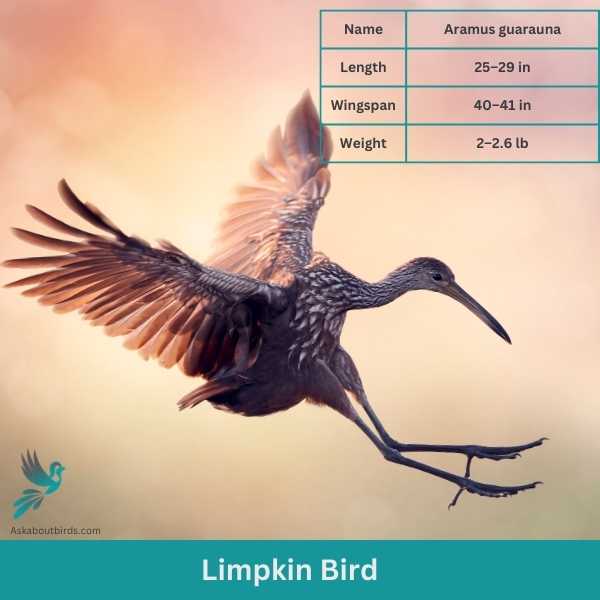
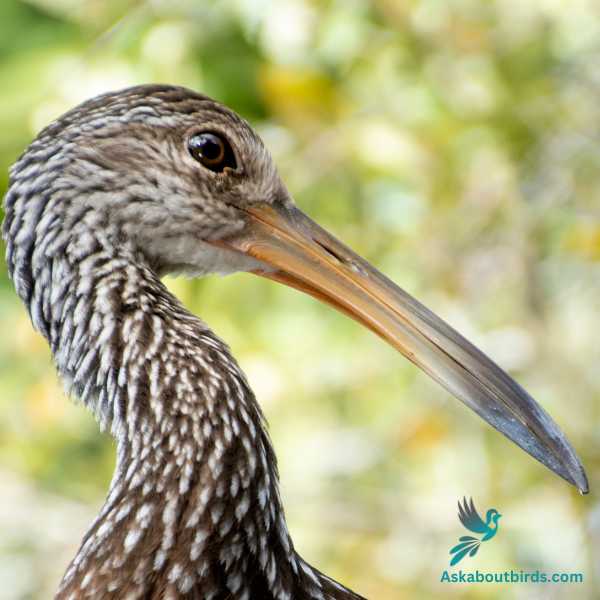
| Feature | Measurement |
|---|---|
| Scientific Name | Aramus guarauna |
| Length | 25–29 in |
| Wingspan | 40–41 in |
| Weight | 2–2.6 lb |
The Limpkin, also known as the “crying bird,” is a distinctive bird due to its unique voice. Found in wetlands, marshes, and swamps, Limpkins are known for their almost exclusive diet of apple snails and freshwater mussels.
The Limpkin is a medium-sized, long-legged bird. It sports a long, down-curved bill which is highly adapted to prying open mollusk shells. The bird’s overall color is a rich brown with white spots and streaks, creating an intricate pattern. Young Limpkins are similar in appearance to adults, but their plumage is a little paler.
The vocal sounds of the Limpkin are striking. They emit a loud, wailing cry, often at dusk or at night, which has earned them the nickname “crying bird.”
Limpkin Bird vs. Crane
Similarities
- Size and Body Shape: Both Limpkins and Cranes are large birds with long legs and necks, allowing them to wade in shallow waters and forage.
- Diet: Both species are primarily carnivorous, feeding on a range of small animals, including mollusks, amphibians, and insects.
- Habitat: Both species can often be found in wetland environments, such as marshes and riverbanks.
Differences
- Color: Limpkins are usually a rich brown color with white spots and streaks, in contrast to Cranes which are usually gray or white, often with additional colors on their heads or necks.
- Bill Shape: Limpkins have a slightly down-curved bill, unlike Cranes that have a straight, pointed bill.
- Voice: Limpkins are known for their loud, wailing calls, which is distinctive and quite different from the calls of Cranes.
FAQS on Birds that look like cranes
What’s a large bird that resembles a crane?
Grey Herons are large wading bird that bears resemblance to cranes, known for its tall stature, long neck, and striking grey plumage.
What other bird looks like a heron?
Egrets, specifically the Great Egret, often get mistaken for herons due to their similar stature and wading habits, though they are usually more white in color.
What birds are mistaken for cranes?
Sandhill Cranes and Great Blue Herons are often confused due to their large size, long legs, and similar habitats.
What bird looks like a crane but a smaller?
The Little Blue Heron may look like a small crane to the untrained eye. It has similar wading habits and shape but is smaller and possesses a bluish hue.




